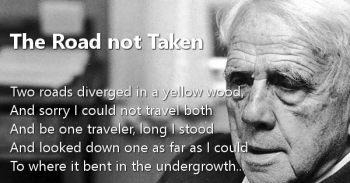Ask Professor Puzzler
Do you have a question you would like to ask Professor Puzzler? Click here to ask your question!
Lately I've been getting a spate of questions about meter in poetry. These question range from "Is this poem iambic pentameter?" to "How do you tell if a syllable is stressed or not?"
Let's start with the second question: How do you tell if a syllable is stressed or not?
If it's trembling uncontrollably, or hiding under the blankets, it's probably a stressed syllable.
Okay, serious answer. A stressed syllable is a syllable that has emphasis within a word (or within a line of poetry). So the best way to tell is to say the word in an overly dramatic way, choosing different syllables to emphasize. For example, let's say we have the word "emphasize," and we want to figure out which syllable is stressed. So we try saying it a few different ways. Try reading the following line, and SHOUT whenever you see a capitalized syllable (or, if you're in a library, whisper when you see a lower-case syllable).
EM-pha-size, em-PHA-size, em-pha-SIZE.
Clearly the middle one sounds WRONG! So we know that the middle syllable is unstressed. But the first and last ones, neither of them sounds horrible, but EM-pha-size definitely sounds better than em-pha-SIZE. EM is the stressed syllable in the word, and the other two are unstressed. You could argue that SIZE has a secondary stress, but the general rule is, only one syllable in a word has the primary stress.
When I was a little kid I could never say the word "aluminum" properly. Let's see if we can work it out by syllables. Get ready to SHOUT again!
A-lu-min-um, a-LU-min-um, a-lu-MIN-um, a-lu-min-UM.
Clearly the one that sounds correct is the second one. Thus, LU is the stressed syllable.
The interesting thing is that if you put multiple words together, we may start hearing some of those "secondary" stresses more clearly:
EM-pha-SIZE a-LU-min-UM.
Those two words sound really great together, because we hear it as alternating stressed and unstressed all the way through. If we switch the order, though, it doesn't sound right to say it that way:
a-LU-min-UM EM-pha-SIZE.
Somehow, those two stressed syllables next to each other sound awkward and cumbersome. However, if we let the UM and SIZE get "swallowed up" and treat them as unstressed syllables:
a-LU-min-um EM-pha-size.
Now it sounds more relaxed and natural. Read this way, the two words sound natural together, because we have a stress every three syllables. It's important to remember that the context of words affects how they are stressed.
Another example of stress being affected by context is the word "present." This word will be pronounced pre-SENT if it is a verb, but PRE-sent if it is a noun. So you always have to think about the meanings of words to determine how they should be read.

So how do you tell if a poem is in a particular meter? Well, to answer that, you need to know what the meters are. For example, anapestic tetrameter means that you have two syllables unstressed, followed by a stressed syllable, and that is repeated four times in a line of poetry. So, for example, if you wanted to know if Robert Frost's "The Road not Taken" is anapestic, you could write it out with the stress on every third syllable:
two roads DI-verged in A yel-low WOOD.
Okay, that sounds just plain silly. I'd say Frost's poem is not anapestic.
What about "The Night Before Christmas"?
'twas the NIGHT be-fore CHRIST-mas and ALL through the HOUSE.
Hey! That sounds nice! That's the way it's supposed to be read! So yes, that is an anapestic poem.
Then there's iambic poetry. A poem is iambic if you start with an unstressed syllable, and then alternate stressed and unstressed. So let's try Shakespeare's famous line "It is the star to every wandering bark." We'll try writing that out with alternating stress:
it IS the STAR to EV-ery WAN-der-ING bark.
Uh oh...that doesn't sound quite right. It worked well until we got to the word "wandering." Then things went screwy. But you know, lots of times, when we say wandering, we don't actually pronounce that middle syllable; we say "wandring." So let's try it that way:
it IS the STAR to EV-ery WAN-dring BARK.
Again, this starts out sounding right, but about the time we get to the word "A," it goes south on us. Who wants to emphasize the word "a" in a poem? Well, that's the thing; Robert Frost knew that if people read his poem naturally, without thinking about meter, the words "in" and "a" would both kind of get swallowed up - almost as though they were one syllable:
Two ROADS di-VERGED (in a) YEL-low WOOD,
and SOR-(ry i) COULD not TRAV-el BOTH
and BE one TRAV'ler, LONG i STOOD
and LOOKED down ONE as FAR (as i) COULD
To WHERE it BENT (in the) UN-der-GROWTH.
Okay, now stop yelling, and go read that stanza in your natural voice. Isn't it beautiful? That's poetry for you!
Related post: How does context affect stress of syllables?

